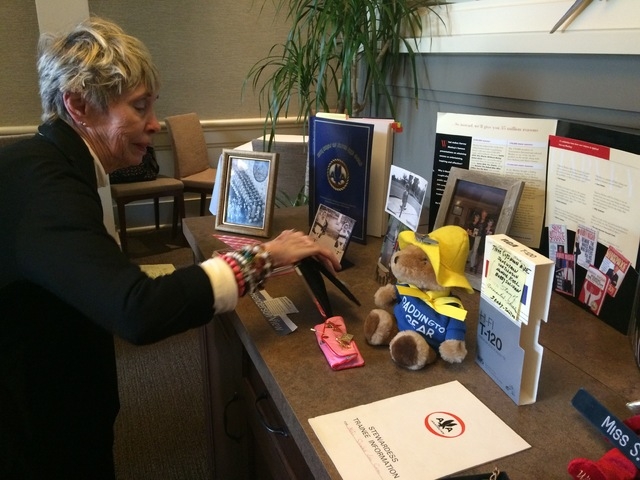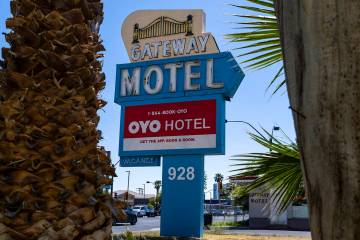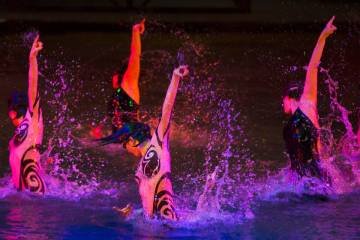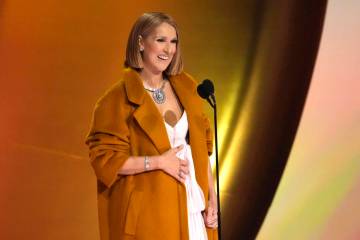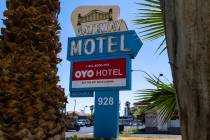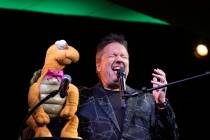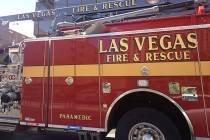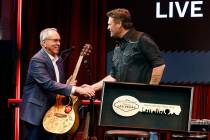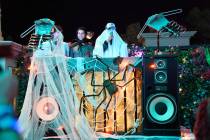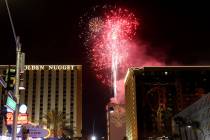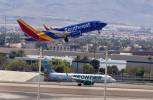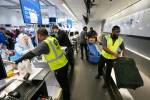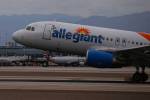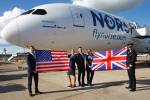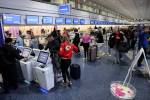Kiwi Club takes flight attendants of yesteryear back in time
They were the darlings of the skies in a job that had them jetting off to exotic locales, flirting with celebrities and catering to the rich who flew only first class. They were flight attendants — still known as “stewardesses” back then — and a handful recently met at Tommy Bahama in Town Square Las Vegas.
Now they’re called “Kiwis,” named for the club made up of former flight attendants. Some began flying in the ’60s and ’70s and have seen a lot of changes over the years: faster jets, the ban on smoking, luggage restrictions and the end of meal service.
There were changes in passengers, too.
“Passengers use to dress like they were going (out for the evening),” said Marilyn Kienke, president of the Las Vegas chapter of the Kiwi Club. “Nobody wore jeans like they do now. And our flight attendant uniforms — we wore gloves and hats.”
The club was established in 1946 and nationally chartered in 1952. The Las Vegas chapter received its charter in 1991. It began as solely for retired flight attendants from American Airlines, but over the years, as more airlines folded, those who had flown for TWA, Trans Caribbean, Reno Air, Ozark and USAir were also welcome to join.
This day, the talk was about recalling silly mishaps: on-board medical situations, overly amorous passengers and memorable celebrities.
Toppy Mitchell flew for American from 1967 to 2013. She said that she “loved every minute of it. It was fun.”
She particularly liked having layovers in Shanghai and London.
Mitchell said one of her favorite memories was in the early ‘80s when American, along with several other airlines, agreed to let flight attendants take leaves of absence to volunteer with the Dr. Tom Dooley Foundation in Laos and Nepal.
“I had no idea which country I would end up in,” Mitchell said, “but, as it turned out, I went to Kathmandu, Nepal, for 3½ months, volunteered in a leper colony teaching basic health and helping to oversee medication dispensing. (It was a) huge culture shock when I arrived, but I didn’t want to leave when it was time to go home. Beautiful, those Nepalese people.”
As was fairly common in the world of airline workers, she lived in one city (Las Vegas) but flew out of another (Los Angeles). She worked a flight to LAX, only to learn of the 9/11 attacks on the World Trade Center. The resulting no-fly edict had her scrambling for a rental car to get home.
On the brighter side, Mitchell was chosen for a flight that took Pope John Paul II back to Rome when he visited the U.S. His plane was dubbed “Shepherd One.”
Mitchell said the job was a lot of fun but that jet lag was a constant companion. When she wasn’t flying to Shanghai or Europe, she and her husband, David, used her passes to see the world.
“He’d tell people we were married half the (total years) that we really were,” she said, “because I was gone half the time.”
Caroline Jones began flying in 1967 and retired in 2001. She said the job is harder now.
“We have shortened layovers, and now that there’s no meal service, the staffing is reduced — the multiple takeoffs and landings,” she said. “I really liked doing that (the meal service) … because it was a great way to interact with the passengers.”
Still, travel is the main benefit, she said, and a way to see the world free.
“They send us everywhere. They could have you in Amarillo one day and Osaka the next,” she said.
Carol Buchanan, who began flying for American in 1960, said she flew every plane, but her favorite was the 747 because it was a wide body. She remembered how it had a cocktail lounge upstairs when it first came on line.
“And they had a lounge for the coach passengers, way in the back,” she said. “In fact, there was a piano back there. … And in first class, we served caviar — that’s where I learned to love caviar.”
The lounges disappeared once the airlines realized they could boost revenue by putting seats there instead.
Sandy Coe began with American in 1965 and had the distinction of being hired along with her identical twin sister, Judy, now deceased. Judy was married to a pilot, and the three of them often worked the same flights. Coe said working with her sister could stun passengers, who often thought they were seeing double.
She flew through 2001. She recalled having The Jackson 5 on one of her New York to L.A. flights.
“Michael was a darling, he was, like, 10 years old,” she said. “He was all excited and told me, ‘We were on Ed Sullivan last night.’ ”
Flying could also be dangerous. Kay Jennings was on a flight that had to make a belly landing when the landing gear jammed. The airport, Carswell Air Force Base in Fort Worth, Texas, foamed the runway in advance of the Boeing 707‘s approach. After it made contact with the ground and skidded down the runway, the flight attendants evacuated the packed plane within the time specified by the Federal Aviation Administration.
There were no injuries, but Jennings was written up by the airline’s inflight office.
“My hat flew off as I was sliding down the evacuation chute,” she said. “Those stupid hats.”
Some flew only a few years because, back in the day, flight attendants had to quit when they got married. Some airlines also forced women to quit when they turned 30 or 32.
All of the club members said they missed the camaraderie and the opportunity to travel. Their meetings are filled with memories, with “’Do you remember when … ?” comments and bringing up things long-forgotten.
Peggy Ganopole flew for TWA for nine years starting in 1954 before moving to Eastern as a recruiter and then working as a VIP concierge at LAX. She was scheduled to work a June 3, 1956, flight — TWA Flight 2 — but swapped out of it. Flight 2 had an in-air collision with United Airlines Flight 718 over the Grand Canyon, resulting in the deaths of all 128 aboard.
She later learned that the woman who picked up the flight in her place, Tracie, wanted it so she could have more time to make wedding preparations.
“Tracie died in the crash,” Ganopole said. “I was devastated, of course. … But it caused me to change my (outlook). I became more positive. I was, like, ‘I’m here. I’m alive.’ ”
She said she didn’t fear flying after that close call and even switched to working international flights.
Coe said the Kiwi Club’s monthly meetings allow her to “go back in time with the girls and reminisce.”
The Las Vegas chapter is one of more than 40 across the U.S. and has 18 members, all women. Altogether, the clubs have raised more than $3 million for various charities, with $369,000 going to the Wings Foundation, which is dedicated to helping American Airlines flight attendants in need.
The Las Vegas chapter adopted the Blue Star Mothers of Henderson & Boulder City as its charity of choice, as many club members have children in the military.
The club’s next meeting is planned for 11 a.m. April 20 at a location yet to be determined. Visit thekiwiclub.org or call Kay Jennings at 702-896-5496.
To reach Summerlin Area View reporter Jan Hogan, email her at jhogan@viewnews.com or call her at 702-387-2949.
Kiwi Club
The club's next meeting is planned for 11 a.m. April 20 at a location yet to be determined.
Visit thekiwiclub.org or call Kay Jennings at 702-896-5496.



